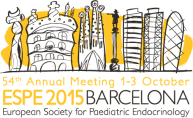
54th Annual ESPE (ESPE 2015)
Barcelona,
Spain
01 Oct 2015 - 03 Oct 2015
Free Communications
Endocrine Oncology/Turner
hrp0084fc5.1 | Endocrine Oncology/Turner | ESPE2015
Resveratrol Potentiates Growth Inhibitory Effects of Rapamycin in PTEN-deficient Lipoma Cells by Suppressing p70S6 Kinase Activity
Leipert Jenny , Kassner Franziska , Schuster Susanne , Handel Norman , Korner Antje , Kiess Wieland , Garten Antje
hrp0084fc5.2 | Endocrine Oncology/Turner | ESPE2015
MEN1 Syndrome Because of Combined Germline and Somatic Mosaicism, with Important Consequences for Relatives
Kempers Marlies , Stikkelbroeck Nike , Mensenkamp Arjen , Pfundt Rolph , van der Luijt Rob , Timmers Henri , Claahsen Hedi , Hoogerbrugge Nicoline , Hermus Ad
hrp0084fc5.3 | Endocrine Oncology/Turner | ESPE2015
Screening in Children with Succinate Dehydrogenase B (SDHB) Mutations: a Single Centre’s Family Clinic Experience
Shapiro Lucy , Srirangalingam Umasuthan , McAndrew Lorraine , Martin Lee , Tufton Nicola , Kumar Ajith , Drake William , Akker Scott , Storr Helen
hrp0084fc5.4 | Endocrine Oncology/Turner | ESPE2015
X Chromosome Gene Dosage and the Risk of Developing Congenital and Acquired Traits in Turner Syndrome: a Cross-Sectional Database Analysis of the French National Rare Disease Network
Zenaty Delphine , Fiot Elodie , Boizeau Priscilla , Haignere Jeremie , Santos Sophie Dos , Carel Jean Claude , Leger Juliane , French Turner Syndrome Study Group
hrp0084fc5.5 | Endocrine Oncology/Turner | ESPE2015
Hereditary Turner Syndrome 46,X,rec(X)inv(p21q28) in Six Women and Four Generations: Estimation of Skeletal Effects of GH Treatment
Stoklasova Judith , Kaprova Jana , Trkova Marie , Nedomova Vera , Zemkova Daniela , Soucek Ondrej , Matyskova Jana , Sumnik Zdenek , Lebl Jan
hrp0084fc5.6 | Endocrine Oncology/Turner | ESPE2015
Anti-Müllerian Hormone Levels in Patients with Turner Syndrome: Relation to Karyotype, Pubertal Development and GH Therapy
Hamza Rasha , Mira Marwa , Hamed Amira



